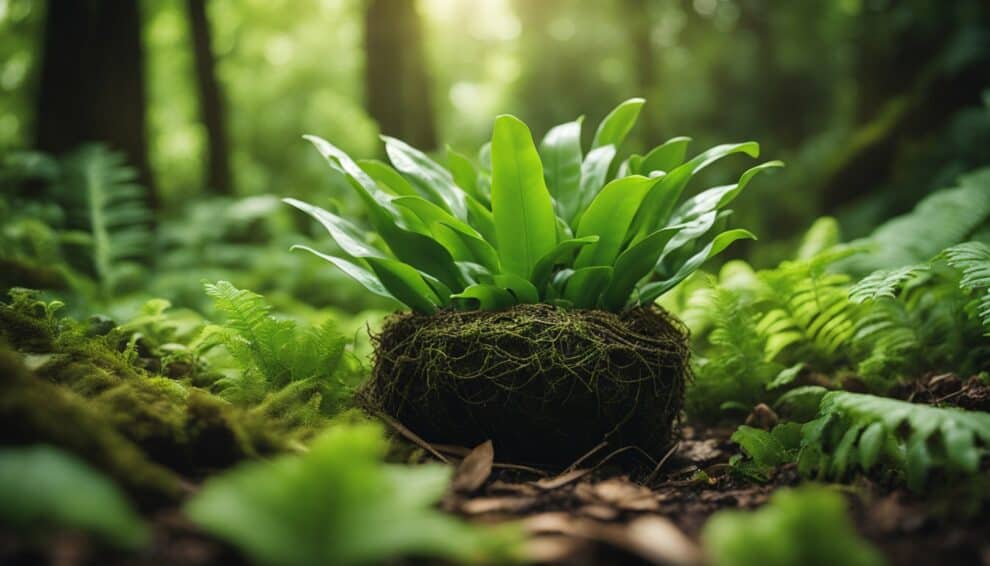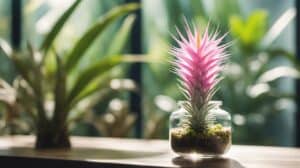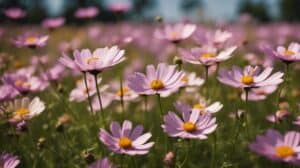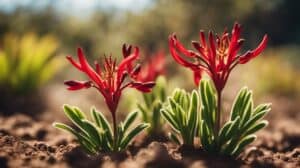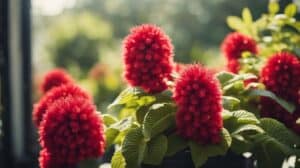Bird’s Nest Fern (Asplenium nidus) is a popular houseplant that is known for its unique appearance and low maintenance requirements. This fern is native to tropical regions and is often found growing in the wild on tree branches or other surfaces. The plant’s fronds grow in a circular pattern, resembling a bird’s nest, hence the name.

One way to enjoy the beauty of this plant is by growing it from scratch. Forest Nest is a method of growing Bird’s Nest Fern that involves mimicking the plant’s natural habitat. This method involves using a substrate that is similar to what the plant would grow in naturally, such as sphagnum moss or coconut coir. The substrate is then placed in a container that is lined with a layer of sphagnum moss, which helps to retain moisture and provides a suitable environment for the fern to grow.
Growing Bird’s Nest Fern using the Forest Nest method is a rewarding experience that allows plant enthusiasts to observe the entire growth process from start to finish. This method also gives the plant a chance to thrive in an environment that closely resembles its natural habitat, which can result in healthier and more vibrant fronds. With a little bit of patience and care, anyone can successfully grow a beautiful Bird’s Nest Fern using the Forest Nest method.
Understanding the Bird’s Nest Fern
Species Overview
The Bird’s Nest Fern, scientifically known as Asplenium nidus, is a popular houseplant that belongs to the fern family. It is native to tropical regions such as Southeast Asia, East Asia, and Australia. The plant is known for its unique appearance, with its long, wavy fronds that resemble a bird’s nest.
The Bird’s Nest Fern is a relatively easy plant to care for, making it a popular choice among indoor gardeners. It can grow up to two feet tall and two feet wide, and it thrives in humid environments with indirect light. The plant’s fronds are usually bright green in color, and they can grow up to three feet in length.
Natural Habitat
The Bird’s Nest Fern is typically found growing in the wild in the rainforests of Southeast Asia, East Asia, and Australia. It is an epiphytic plant, which means that it grows on other plants rather than in soil. In its natural habitat, the plant can be found growing on trees, rocks, and other surfaces.
The plant’s ability to grow on other surfaces is due to its unique root system. The Bird’s Nest Fern has a mass of wiry roots that attach to the surface on which it is growing. These roots are not used for absorbing water and nutrients, but rather for anchoring the plant in place. The plant absorbs water and nutrients through its fronds, which have small scales on the underside that help to trap moisture.
Overall, the Bird’s Nest Fern is a fascinating plant with a unique appearance and easy care requirements. Understanding its natural habitat and growth habits can help indoor gardeners provide the best possible care for their ferns.
Cultivation Basics

Choosing the Right Spores
To grow a healthy bird’s nest fern, it’s important to start with the right spores. Look for spores that are fresh and viable, as older spores may not germinate as well. You can purchase spores from a reputable supplier or collect them from mature fronds.
Suitable Growth Medium
Bird’s nest ferns thrive in a well-draining, nutrient-rich soil mix. A mix of peat moss, perlite, and vermiculite is ideal for growing bird’s nest ferns. You can also add organic matter such as compost or leaf mold to the mix to provide additional nutrients.
Temperature and Humidity Requirements
Bird’s nest ferns prefer warm, humid conditions. They thrive in temperatures between 60-80°F (15-27°C) and require humidity levels between 50-70%. To maintain the required humidity levels, you can mist the fern regularly, place a humidifier nearby, or grow the fern in a terrarium.
Overall, growing bird’s nest ferns from scratch requires attention to detail and patience. By choosing the right spores, providing a suitable growth medium, and maintaining the right temperature and humidity levels, you can successfully cultivate a healthy and vibrant bird’s nest fern.
Planting and Care

Sowing the Spores
To start growing a bird’s nest fern from scratch, one must first obtain the spores. These spores can be purchased from a nursery or obtained from a mature bird’s nest fern. Once the spores are obtained, they can be sown on a moist growing medium, such as sphagnum moss or a mixture of peat moss and perlite. The spores should be sprinkled on top of the growing medium and misted with water to keep the surface moist. The container should then be covered with plastic wrap to maintain humidity and kept in a warm, bright location.
Watering Techniques
Watering is an essential part of caring for a bird’s nest fern. The soil should be kept consistently moist, but not waterlogged. Overwatering can lead to root rot, while underwatering can cause the leaves to wilt and turn brown. To water the fern, it is best to pour water directly into the soil, rather than on the leaves. This will prevent water from collecting in the center of the plant, which can lead to rot. The frequency of watering will depend on the humidity and temperature of the environment, but generally, the fern should be watered once or twice a week.
Fertilizing Schedule
Bird’s nest ferns do not require a lot of fertilizer, but they do benefit from occasional feeding. A balanced, water-soluble fertilizer can be applied every two to three months during the growing season (spring and summer). It is important not to over-fertilize, as this can lead to burnt leaves and other problems. It is also a good idea to flush the soil with water every few months to prevent salt buildup from the fertilizer.
Troubleshooting Common Issues

Dealing with Pests
Bird’s Nest Ferns are generally resistant to pests, but they can still fall prey to common houseplant pests. If you notice any signs of infestation, such as webbing or tiny insects, it’s important to act quickly to prevent the problem from spreading.
One effective way to deal with pests is to regularly inspect your fern for any signs of trouble. You can also use a gentle insecticidal soap to get rid of any pests that you find. Be sure to follow the instructions on the label carefully, and avoid using any harsh chemical sprays that could damage your fern.
Fungal Diseases Prevention
Fungal diseases can be a problem for Bird’s Nest Ferns, especially if they are kept in a humid environment. To prevent fungal diseases, it’s important to ensure that your fern is not overwatered and that it has good air circulation.
If you notice any signs of fungal disease, such as spots or discoloration on the leaves, it’s important to act quickly to prevent the problem from spreading. You can use a fungicide to treat the affected areas, but be sure to follow the instructions carefully and avoid using any harsh chemicals that could damage your fern.
Addressing Yellowing Leaves
Yellowing leaves are a common issue with Bird’s Nest Ferns, and they can be caused by a variety of factors. One common cause is overwatering, which can lead to root rot and other problems.
To address yellowing leaves, it’s important to ensure that your fern is not overwatered and that it has good drainage. You can also try trimming off any yellow or brown leaves to encourage new growth.
Overall, with a little bit of care and attention, you can keep your Bird’s Nest Fern healthy and thriving for years to come.
Frequently Asked Questions

How can I propagate a bird’s nest fern effectively?
Bird’s nest ferns can be propagated through spores or division. If you choose to propagate through spores, you will need to gather the spores and sow them onto a suitable substrate. For division, carefully separate the offsets from the mother plant and plant them in a suitable potting mix.
What are the ideal growing conditions for bird’s nest ferns?
Bird’s nest ferns prefer a warm and humid environment with filtered or indirect light. They thrive in well-draining soil that is kept moist but not waterlogged. They should be kept away from direct sunlight and cold drafts.
Can bird’s nest ferns be cultivated in water alone?
Bird’s nest ferns can be grown in water, but it is not recommended as a long-term solution. They need nutrients from soil to thrive, and water alone may not provide enough nutrients for sustained growth.
What type of fertilizer should be used for bird’s nest ferns?
A balanced, water-soluble fertilizer with equal amounts of nitrogen, phosphorus, and potassium is ideal for bird’s nest ferns. Fertilize once a month during the growing season and reduce fertilization during the dormant season.
What is the expected vase life of a bird’s nest fern?
Bird’s nest ferns can last for several weeks as a cut flower in a vase. However, the vase life will depend on the condition of the fern, the environment it is kept in, and how it is cared for.
What is the symbolism or meaning behind bird’s nest ferns?
Bird’s nest ferns are often associated with new beginnings, growth, and renewal. They are also believed to bring good luck and prosperity to the home.






